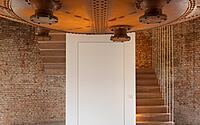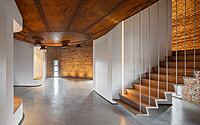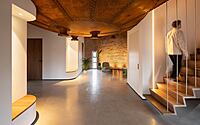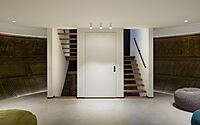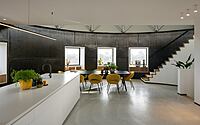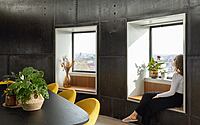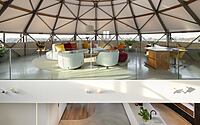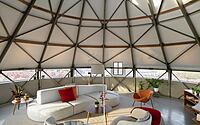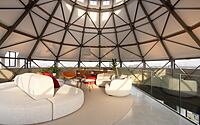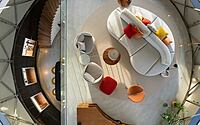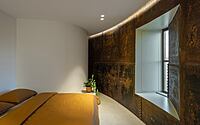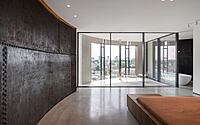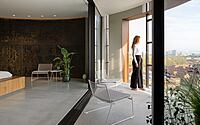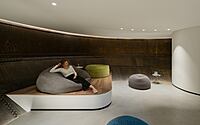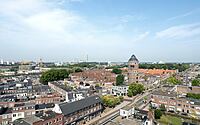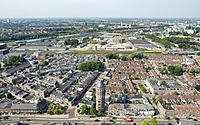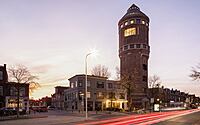Watertoren Utrecht by Zecc Architecten
Watertoren Utrecht is a historic water tower in Utrecht, the Netherlands, transformed in 2022 by Zecc Architecten into an exclusive six-story residence, with three apartments and commercial space on the ground floor.

















Description
After years of vacancy, the water tower on the Amsterdamsestraatweg in Utrecht has been given a new destination. In 2012, the dilapidated national monument was purchased by a private client and Zecc made the design for the transformation into an exclusive six-storey residence (in the former water reservoir), three apartments (in the lower part of the tower) and a commercial space on the ground floor. The challenge for this design lay in creating good daylight openings, a beautiful outdoor area with a view of the Dom and good access with a lift and safe stairwell. Interventions that have been carefully integrated into the Amsterdam School architecture of the more than 100-year-old monument.
In the lower part of the water tower, from the first to the third floor, three identical studio apartments have been realized on the existing floors. The character of the sturdy brickwork and the wooden or concrete beams has been preserved here as much as possible. There was sufficient height on these layers to create a compact volume with a sleeping area on the mezzanine floor and with integrated kitchen, bathroom and (lift) shaft at the bottom. From the elevator you step directly into the apartment. A solution that gives an exclusive feeling and at the same time saves space. For the studio apartments, three large openings have been made in the facade as a new ‘time layer’ with steel folding doors in a Corten steel frame. When the facade is fully opened, a compact loggia is created in the house as an outdoor space.
At the top of the water tower, in the former water reservoir, is a house of 400 m2 over six floors. The house starts on the fourth floor on the concrete leak floor. Here is the entrance and access to a private elevator. The bottom of the water tank, made of sheet steel with coarse rivets, is clearly visible here. The warm rust color and the brickwork made visible again, combined with the white and walnut wood of the new interventions, provide a light, warm and unique entrance to the house.
In the ‘journey’ upwards, the more private functions have been placed at the bottom, such as guest rooms, relaxation area and storage space. The space becomes more and more open towards the top, creating a spectacular succession of floors, voids and views. The rust-colored steel walls of the reservoir are visible throughout the house. Together with the floated concrete floor, they give the house a warm and industrial character. The new interventions made with white, modern volumes and walnut parts complete this balance.
After the entrance you step via the hanging staircase through an incision in the reservoir to the fifth floor, where there is a free space in the rounded bottom part of the reservoir. This space can be used in various ways; business presentations, film screenings or, for example, a house concert. There is no natural daylight here, but with the new wooden staircase, the daylight is brought down.
The sixth floor is divided into 3 guest rooms with associated facilities. Here the incisions in the steel reservoir, which provide daylight, become larger and the relationship with the environment and the view becomes stronger. The openings in the reservoir have been handled in different ways, creating a suitable perception of daylight and the environment for each room and function. In the lower sleeping quarters, the steel has been cut and folded away towards the existing openings in the masonry facade. As a result, your gaze is focused, grazing light falls in and the character of the steel reservoir is preserved due to the relatively small incisions.
The seventh floor is all for the master bedroom with bathroom and dressing room. The layout was chosen to provide an amazing view of the (awakening) city at rising sun and the Dom tower in the city center of Utrecht. A large opening has been made in the reservoir and in the masonry outer wall for this purpose. A loggia has been created to strengthen the bond with the location. The original vertical window strips in the outer facade continue across the facade as a reminder of the original facade. The furnishings with walnut accents, plants and upholstery guarantee the warm, homely atmosphere that belongs to a home. The lighting is also used to strengthen this and is fully adjustable according to the needs per person per moment.
The kitchen is located on the eighth floor. Here large openings have been made in the reservoir and enlarged windows in the facade. They provide plenty of daylight, are functional as a seat, offer extra storage space and work like beautiful ‘paintings’ of the environment. A large void offers a view of the phenomenal roof construction. A spatial connection with the living room on the ninth floor has also been made. Walnut accents, colorful upholstery of the furniture and greenery have been used in the interior.
The space on the ninth floor is overwhelming. Under the high roof construction of steel and wood, panoramic windows have been made all around for a 360-degree view. The new living room floor has been installed at a height so that you can see the horizon while sitting and have a view over the city. The round island of loose furniture ensures that this feeling is reinforced and that a certain degree of homeliness is created in such a high space.
Just like on other layers in the tower, the atmosphere is sturdy and industrial combined with homely and intimate. The basis of the choice of materials was already present: the warm color and texture of the masonry, anthracite-coloured steel frames, the rusted reservoir of nailed sheet steel and the light gray steel trusses of the roof construction. This has been supplemented with concrete floors, white interior walls and warm walnut accents (which match the rust color of the reservoir) in the floors, wall parts and in the furniture. In the loose interior, this palette is supplemented with natural and earthy colors, making the whole a tough but very homely whole.
Expansion
In the future, a commercial function such as a coffee corner or barbershop will be built on the ground floor. In this way, the tower is also made accessible to the public. At the rear, now a vacant lot on Hyacintstraat, compact homes will be added and a built parking facility. This separates the urban development block and the water tower, which as a free-standing monument continues to determine the identity of the Amsterdamsestraatweg.
Photography by Zecc Architecten and Stijn Poelstra
Visit Zecc Architecten
- by Matt Watts
